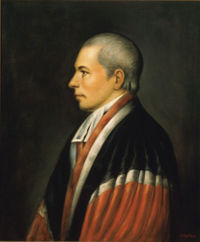William Paterson
 From Conservapedia
From Conservapedia | William Paterson | |||
|---|---|---|---|
| |||
| Former Associate Justice of the U.S. Supreme Court From: March 4, 1793 – September 9, 1806 | |||
| Nominator | George Washington | ||
| Predecessor | Thomas Johnson | ||
| Successor | Henry Brockholst Livingston | ||
| 2nd Governor of New Jersey From: October 29, 1790 – March 30, 1793 | |||
| Predecessor | Elisha Lawrence | ||
| Successor | Thomas Henderson | ||
| U.S. Senator from New Jersey From: March 4, 1789 – November 13, 1790 | |||
| Predecessor | None | ||
| Successor | Philemon Dickinson | ||
| Information | |||
| Party | Federalist | ||
| Religion | Presbyterian | ||
William Paterson (December 24, 1745 – September 9, 1806) was an Associate Justice of the Supreme Court of the United States in addition to being a New Jersey statesman and a delegate to the 1787 Constitutional Convention, where he proposed the New Jersey Plan.[1]
Patterson was one of the authors of the Judiciary Act of 1789 - which created the federal legal structure he would soon be a part of.[2] On the Supreme Court, his role as a framer gave credence to what he cited as the original intent of the drafters of the Constitution.
Contents
Early life[edit]
Paterson was born in County Antrim, Ireland. His family immigrated to America, where he attended The College of New Jersey(later named Princeton University), graduating in 1763. While at Princeton, Paterson was a founder of the Cliosophic Society.[3]
Following his graduation, Paterson studied law under Richard Stockton. He was admitted to the bar in 1768 and commenced practice in New Bromley, New Jersey, in 1769.[4]
Political career[edit]
Early in his career, Paterson embraced the cause of independence. He served as the secretary of New Jersey's Provincial Congress from 1775-1776, and also served as a delegate to New Jersey's first constitutional convention. During the Revolutionary War, he served on New Jersey's Council of Safety. In 1776, he assumed the post of Attorney General for New Jersey, declining appointment to the Continental Congress in 1780 because of his responsibilities.[5]
Constitutional Convention[edit]
Paterson played a critical role in the creation of the United States Constitution. As co-author of the New Jersey Plan, he called for an equal voice for all states in the national legislature. Eventually, a compromise was reached between this plan and the Virginia Plan proposed by those who felt that representation should be based on population; the result was the bicameral Congress we know today.
Other members of the New Jersey delegation to the Convention were Jonathan Dayton, William Houston, William Livingston, and David Brearley.
Later Political Service[edit]
Following the Constitutional Convention, Paterson went on to become one of New Jersey's first senators in 1789. As a member of the Senate, he served on the Senate Judiciary Committee, where he helped to draft the Judiciary Act of 1789 that established the federal court system.
In 1790 he resigned from the Senate in order to serve as Governor of New Jersey. Paterson served in that capacity until 1793, when he resigned to become an associate justice of the Supreme Court—a position he held until his death in 1806. As a Supreme Court justice, Paterson continued to support states' rights and the principle of a government which was subordinate to the law.[6]
Death[edit]
William Paterson died on September 9, 1806, in Albany, New York. He was interred in the family vault at Van Rensselear Manor; later, upon the destruction of the house, he was reinterred in Albany Rural Cemetery.
References[edit]
- ↑ William Paterson (English). Oyez. Chicago-Kent School of Law.
- ↑ William Paterson - Jersey, Court, Supreme, Constitution, Congress, and Created (English). law.jrank.
- ↑ The Duel: The Parallel Lives of Alexander Hamilton and Aaron Burr
- ↑ http://www.history.army.mil/books/RevWar/ss/paterson.htm
- ↑ http://www.history.army.mil/books/RevWar/ss/paterson.htm
- ↑ http://www.history.army.mil/books/RevWar/ss/paterson.htm
Categories: [Founding Fathers] [New Jersey Governors] [American Revolution]
↧ Download as ZWI file | Last modified: 02/05/2023 20:25:30 | 13 views
☰ Source: https://www.conservapedia.com/William_Paterson | License: CC BY-SA 3.0
 ZWI signed:
ZWI signed:
 KSF
KSF